Table of Contents Show
Fandom is a key component of meme culture on YouTube; people on the platform who share the same interests gather and discuss elements of the desired subject that are obscure or not well-known. “Iceberg videos” embody this fandom; copious amounts of research go into a video to reveal information about a particular subject to pique the curiosity of those interested. This research is then organized into “tiers” or levels, with each level depicting how accessible or how well-known that aspect of a fandom is.
The meme, in this case, is the iceberg, modified slightly by each user to fit the content of the specific subject. For example, a fan of Kanye West decides to make a “Kanye West iceberg” video in order to reveal facts one may not know about his music, life, etc. This fan will then organize the information he finds about Kanye into “tiers of an iceberg.” Details at the tip of the iceberg represent information commonly known about Kanye throughout the fandom or in larger society. However, because the tip of the iceberg only accounts for a small portion of everything that characterizes Kanye, most of the material on Kanye will be “submerged underwater” or unknown to the traditional fan.
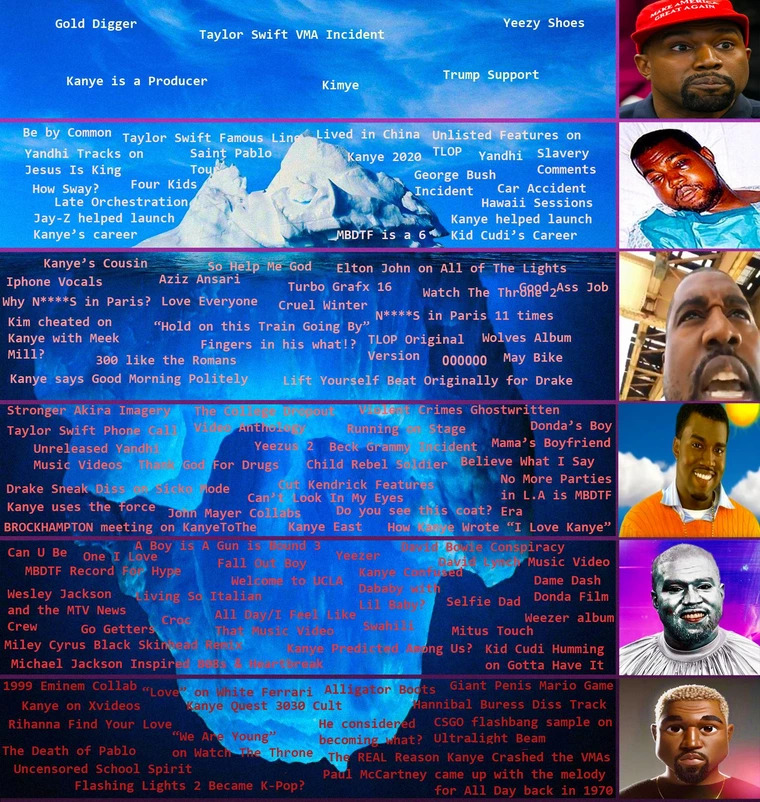
From the bottom of the iceberg to above sea level, information ranging from unreleased songs to unknown hip hop group formations (all relating to Kanye) will be organized according to their mysteriousness. Typically, in an iceberg video, the most mysterious phenomena regarding the subject will appear at the bottom of the iceberg. As a result, the viewer will have a more extensive understanding of a person or culture after watching the video. Additionally, iceberg memes and their bizarre qualities manifest in academia, with psychological icebergs and cultural studies icebergs as prime examples. Research in both fields uses an iceberg to contrast elements that are well-understood with elements that are often puzzling yet fundamental for the subject matter. Thus, the iceberg not only satisfies the curiosity of those invested in online meme culture but also has a foundational role in academic research. This article will alternate between describing the iceberg’s role in academia and YouTube culture.
Psychological Icebergs
The iceberg is often used in psychological research to characterize the relationship between the conscious and unconscious mind. Generally, the obscurity of the unconscious is represented by the lower portion of the iceberg, whereas as the more understood consciousness is represented by the upper portion of the iceberg. Sigmund Freud’s contribution to psychoanalysis is embodied by this organization, revealing how the most important part of the mind (the unconscious mind) is the part that is most peculiar. Similarly, iceberg videos on YouTube mirror this same behavioral analysis. Videos ranging from investigating YouTube itself to Google Maps to musical artists are oriented around giving the viewer an in-depth look at their inconspicuous qualities.
YouTube Iceberg + Psychology
Investigations into the conscious, preconscious, and unconscious often use an iceberg to symbolize the potency of each stage. In the article, “Freud and the Unconscious Mind,” author Dr. Saul McLeod uncovers the research of Sigmund Freud. Freud used an iceberg to represent how these three levels of the mind function independently while contributing to the totality of the mind’s operation. While the conscious and preconscious systems operate with a certain level of self-awareness, the unconscious is mostly responsible for this behavior, housing information that is obscure and uncomfortable, yet integral for human function:
According to Freud (1915), the unconscious mind is the primary source of human behavior… Our feelings, motives and decisions are actually powerfully influenced by our past experiences, and stored in the unconscious
(( McLeod, S. A. (2015). Unconscious mind. Simply Psychology. Accessed 2 Sept. 2021. )).
According to McLeod and Freud’s research, the most disturbing aspects of human thought are kept within the unconscious. Thus, information that humans do not want to confront on a conscious level becomes a central component of the unconscious portion of the mind. As a repository, it contains the majority of the human desires, interests, and feelings that shape experience and is largely responsible for each person’s motivations and decision-making. In this sense, the iceberg’s unconscious level contains all the elements essential for thought but largely incomprehensible and hidden. This abstruseness of the iceberg’s lower majority can be applied to icebergs videos that explore YouTube.
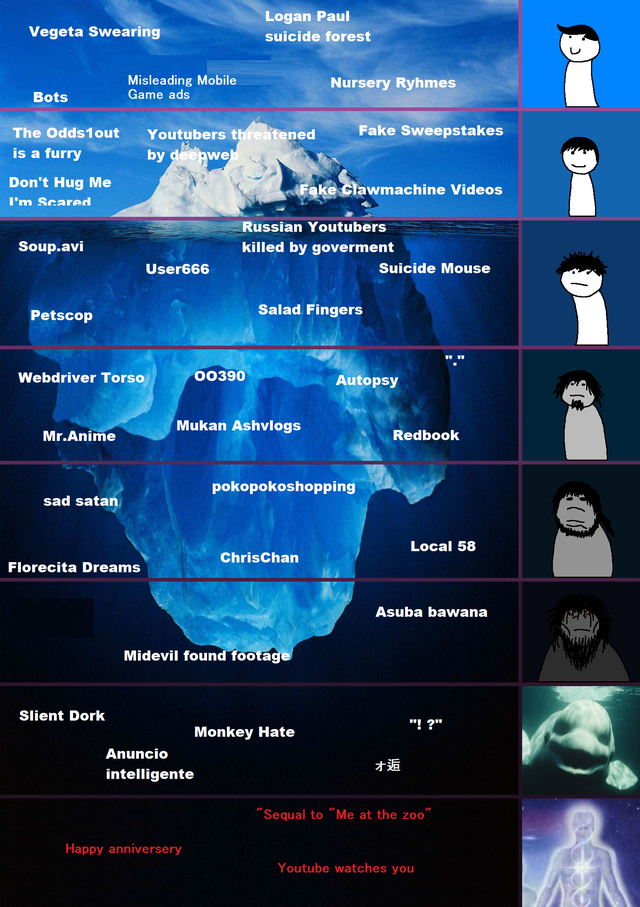
Iceberg videos on YouTube are shrouded in nebulousness, especially if a particular video focuses on the platform of YouTube itself. YouTuber Parallel Pipes undertakes such a project on the video, “This Youtube Iceberg Explained.” He investigates a particular iceberg supplied by Reddit user Recent_Silver8509 (( Parallel Pipes. “This YouTube Iceberg Explained.” 22 Dec. 2020. )) which lists aspects of YouTube that range from common and well-understood to peculiar and disturbing. Parallel Pipes dives into each detail, describing the origin and strangeness of each factoid regarding YouTube. Like the obscurity of the unconscious discussed earlier, the depths of this specific YouTube iceberg contain largely unknown information that would be uncomfortable for the traditional YouTube fan.
At one point, Parallel Pipes discusses how there is a community on YouTube that appears to be dedicated to “hating monkeys” (appears near the bottom of the iceberg). Videos on YouTube, along with YouTube comments that express an unnerving level of disdain towards monkeys, are buried within the platform (( Parallel Pipes. “This YouTube Iceberg Explained.” 22 Dec. 2020. )). Groups such as these should come as no surprise to anyone familiar with online culture; the internet allows enough room for any community to offer unreserved commentary and opinions about a topic of interest. However, the existence of groups like this points to a more broad reality of YouTube: the foundation of YouTube consists of unrestrained and unfiltered information, indicating a vast and seemingly unending internet culture.
Furthermore, the foundation for YouTube cannot be truly explained without a reference to its beginning. Parallel Pipes discusses one of the lowest points in the iceberg, titled (incorrectly) “Sequal to “Me at the zoo.” For those unfamiliar, “Me at the zoo” is the first-ever video uploaded on YouTube, so its status as an introduction to YouTube is well-received and highly popular. However, as Parallel Pipes explains, the video was the subject of many problems, including hacking, spam commenting, and the constant alteration of the video’s description. At one point, the description was changed to notify the viewer that there will be an “update” or “sequel” video to “Me at the zoo” once jawed (the channel that uploaded the video) hits 10 million subscribers (( Parallel Pipes. “This YouTube Iceberg Explained.” 22 Dec. 2020. )). This promise of an update, of course, was false, but this alteration demonstrates how YouTube culture harbors a significant amount of bizarre desires. This undesired occurrence shows a whole new side to the platform that viewers would not have considered had they not been exposed to the iceberg.
Google Maps Iceberg + Psychology
The relationship between the unconscious and conscious mind, as depicted by the iceberg, can be further explained by the concept of a Freudian Slip. When a Freudian Slip occurs, people reveal desires or feelings that were originally kept in the unconscious. As author Kendra Cherry explains in “The Preconscious, Conscious, and Unconscious Minds,” an example of a Freudian Slip includes “a man who accidentally uses a former girlfriend’s name when referring to a current girlfriend” (( Cherry, Kendra. “The Preconscious, Conscious, and Unconscious Minds.” Verywell Mind, 9 Dec. 2020, Accessed 3 Sept. 2021. )). In this sense, the ‘Freudian Slip’ can be seen as the sudden and unexpected surfacing of hidden feelings to consciousness. Although the unconscious is an immense reservoir of emotions, feelings, and memories kept away from conscious awareness, both levels can intermingle, representing a more fluid relationship between the conscious and unconscious. The iceberg demonstrates this dynamic effectively; the surfacing of hidden and uncomfortable concepts can be depicted through this metaphor.
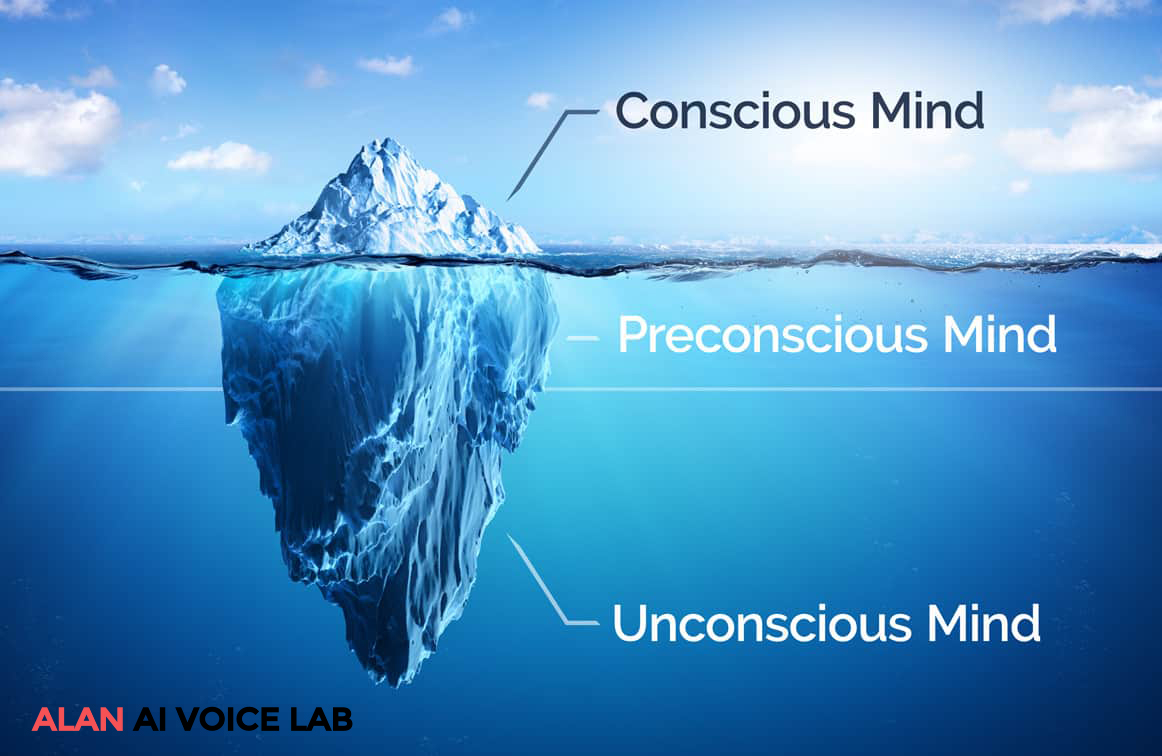
Another YouTube iceberg that mirrors this accidental surfacing of obscure information is the Google Maps Anomaly Iceberg, introduced on the Parallel Pipes video, “The Google Maps Anomaly Iceberg Explained.” The iceberg presents information regarding irregularities one can see while using Google Maps (( Parallel Pipes. “The Google Maps Anomaly Iceberg Explained.” 17 July. 2021. )). For instance, a lower point in the iceberg references the murder of fourteen-year-old Kevin Barrera (incorrectly named Jose Barrera in the video) and how his body was captured on Google Maps satellites (( Debolt, David. “Captured on Google Maps, a 4-year-old murder haunts a Richmond family.” The Mercury News, MediaNews Group, Inc., 12 Aug. 2016. Accessed 3 Sept. 2021. )).

Initially, the satellites captured his body lying near train tracks in Richmond, California. In response, the family requested that the image be removed from Google’s site. Thus, the dubiousness of Google Maps is fully actualized once information that is uncomfortable and unknown to the online user can suddenly appear, similar to how the Freudian Slip raises undesired information from the unconscious.
Tyler, the Creator Iceberg + Psychology
Although the unconscious mind acts as a container for the unpleasant aspects of thought, its ability to process information at a rapid pace showcases an adaptive quality. As a result, the majority of the human mind’s operation occurs through the unconscious. This is a key idea in the James L. Oschman article “An Anatomical, Biophysical and Quantum Basis for the Unconscious Mind.” The article includes a crude illustration (pictured below) of an iceberg to visualize the enormity of unconscious in comparison to the preconscious and conscious sections of the mind. In addition to acting as a repository, the unconscious can “also integrate life events happening over a long or short period of time,” allowing both the conscious and unconscious to “function simultaneously with psychological barriers between them” (( Oschman, James L. “An Anatomical, Biochemical, Biophysical and Quantum Basis for the Unconscious Mind.” International Journal of Transpersonal Studies, vol. 33, no. 1, 14 July 2016, pp. 77–96. )). Thus, one can notice a “back and forth” relationship between both levels of the mind. The unconscious clearly influences conscious activity; its ability to integrate and process constant stimuli over time affects human awareness and decision-making.
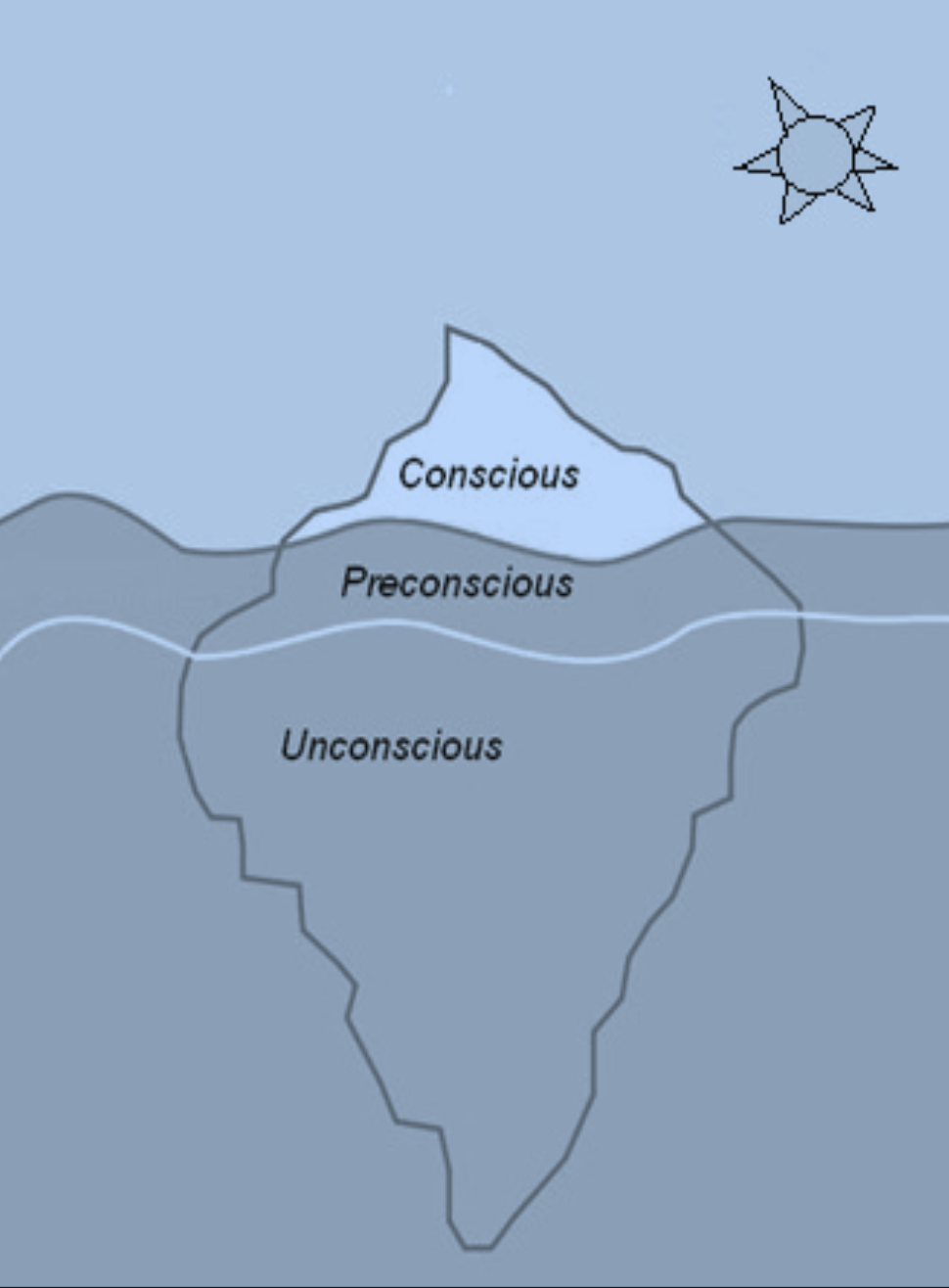
The iceberg as a representative of the mind’s dynamic qualities has applications on YouTube. Specifically, iceberg analysis videos that investigate musical artists reveal creative information that one may not have already known or one may not have considered about that person. This is especially true in the video “The Tyler, The Creator Iceberg Explained” by the channel, drewsome. Tyler, The Creator is a prominent rap artist who is known for his eccentric and unpredictable style. Certain aspects of his career are strange and make up lower portions of the iceberg that analyzes him, such as how he was banned at one point from the UK and New Zealand due to controversial song lyrics (( drewsome. “The Tyler, The Creator Iceberg Explained.” 1 May. 2021. )).

However, one dynamic yet probably overlooked quality of his music is how he takes advantage of album arrangement on his projects. On every one of his albums, Tyler makes his tenth song a “double-track,” meaning that he stretches his creative idiosyncrasies over time throughout his projects. This facet of Tyler’s work appears on the third level of the iceberg below surface-level (( drewsome. “The Tyler, The Creator Iceberg Explained.” 1 May. 2021. )). The iceberg depths do not simply have to represent incongruous aspects of a culture or field of study; they can represent a level of inventiveness that one may not have considered before. Similar to how the unconscious mind integrates life events occurring over time, Tyler, the Creator integrates the idea of a double-song on the tenth track over time in his body of work. This idea is not unpleasant nor mystifying; it demonstrates the value of remaining zestful to create some semblance of predictability.
Cultural Studies Icebergs
In cultural studies, the iceberg has been used as an analogy to delineate the essence of culture; elements that are hard to see and easily understood make up the lower and upper portions of the iceberg, respectively. Edward T. Hall is considered the central figure in this iceberg creation, generating an iceberg model of culture in the 1970s. Items of culture that are clearly visible such as food, music, and language, make up the outside portion. In contrast, hidden items feature more obscure and behavioral foundations of culture, such as beliefs, values, and expectations. The representation of culture through this obscure/common duality aligns with the psychological iceberg from before; however, this iceberg is more oriented to revealing tangible achievements in human society. For that reason, YouTube iceberg videos focusing on music and media align with this way of categorizing culture.
Kanye West Iceberg and Cultural Studies
One aspect of Edward T. Hall’s iceberg analogy of culture that is important to emphasize is how the small, visible portion of the iceberg represents what humans see on a first impression of culture. In “The Impact Of Cultural Intelligence (CQ) On Global Business,” author Ana Mihaela Istrate compares the submerged and visible portions of the iceberg, stating that the upper level “includes… language, dressing code, folklore… all the elements we see at first glimpse” while “beliefs, values, unconscious feelings” are below sea level. (( Istrate, Ana Mihaela. “The Impact Of Cultural Intelligence (CQ) On Global Business.” Romanian Economic And Business Review, vol. 14, no. 3, 2019, pp. 44–49. )). Observers of a new culture are predisposed to making judgments during their first exposure. Surface-level attributes impact the way people interpret culture, although the “submerged” reasons why those features exist are not considered. This is especially the case when discussing musicians with a controversial history; their “unseen” personal desires support the motivations for their “seen” actions.
If any musician or artist embodies this controversy, Kanye West fits the description perfectly. Analyzing the history of Kanye’s music and life, one will uncover various layered meanings and motivations, giving the viewer an in-depth look at his career that extends beyond what is visible on the surface. YouTube channel Doctor Skipper does this on the video “The Kanye West Iceberg Explained,” in which he investigates a Kanye West Iceberg that may not have as much information as others but characterizes obscure motivations for his art. On the particular iceberg Doctor Skipper dissects, the idea that Kanye’s My Beautiful Dark Twisted Fantasy has multiple/layered meanings comprises the lower section of the iceberg (( Doctor Skipper. “The Kanye West Iceberg Explained.” 18 Feb. 2021. )). What is visible to the listener is the surface-level composition of the music (instrumentation, the basic meaning of the lyrics, choruses). However, it is important to consider how the music’s complexity and the purpose for its existence is hidden deep within the iceberg.

A prime example of this hidden complexity is Kanye’s influential song “Runaway,” which appears on My Beautiful Dark Twisted Fantasy. Considered to be one of West’s greatest songs, “Runaway” contains deep, conflicted meanings about Kanye’s personal life and perhaps an additional meaning about the mistreatment of women (( Doctor Skipper. “The Kanye West Iceberg Explained.” 18 Feb. 2021. )). The track’s significance is placed deep within the iceberg, demonstrating the potency of the song’s nine-minute run time. When considering the song at face value, one can see signs of struggle and pessimism. Below the surface, though, one can uncover a variety of meanings, especially if one considers Kanye’s incident at the 2009 MTV awards with Taylor Swift and his complicated relationship with Kim Kardashian. Information like this arranged through an iceberg and explained on YouTube properly characterizes culture and its hidden foundations.
Nickelodeon Iceberg and Cultural Studies
An important hidden aspect of culture is the environment that lays the groundwork for all visible rituals and customs. Alizera Akbari’s article in the International Journal of Humanities and Cultural Studies notes this in a description of the Iceberg Theory. Akbari states that the most prominent and well-known aspects of culture include laws and tendencies of social interaction. However, these elements only occupy the “tip” of the cultural iceberg, and the most influential parts of culture are parts that are “below the surface.” The term ‘value orientation’ characterizes these powerful aspects of culture, which includes action, communication, and environment (( Akbari, Alireza. “Spider-Web Lattice vs. Iceberg Theory: Which One Holds Sway over in Cultural Translation.” International Journal Of Humanities And Cultural Studies, vol. 2, no. 4, 2016, pp. 54–72. )). Essentially, these three broad cultural concepts exemplify the part of culture that is not immediately obvious to the observer. This is particularly the case with “environment;” the social atmosphere established by a culture is not easily visible but defines the integrity of the culture.
The notion of “environment” shaping the outward appearance of a culture has a somewhat disturbing relevance when discussing the culture of Nickelodeon. The iceberg that characterizes this television channel portrays Nickelodeon’s culture in a way that the viewer may not have considered before. Doctor Skipper explains the basis of this environment in the YouTube video, “The Nickelodeon Iceberg Explained.” The iceberg he references has a tidbit at the bottom that references a “Dan Schneider Foot Fetish” (( Doctor Skipper. “The Nickelodeon Iceberg Explained.” 6 Feb. 2021. )). This bizarre factoid is a highly controversial characterization of TV producer Dan Schneider’s type of behavior when producing various teen sitcoms on Nickelodeon.
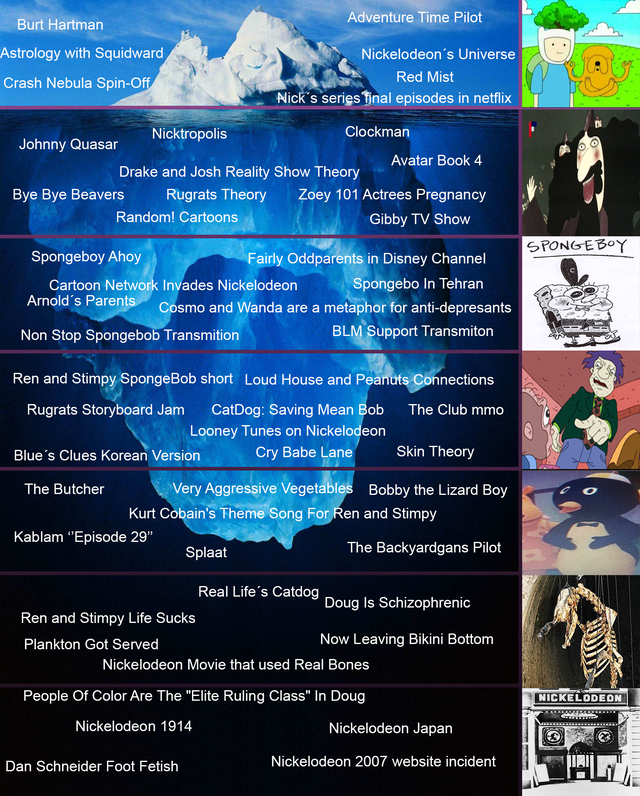
According to Doctor Skipper, Schneider expressed an interest in having the various actors on Nickelodeon “showcase” their feet in promotional settings and within the shows themselves. In programs such as iCarly and Victorious, one will notice many instances of actors performing scenes with their feet that one may find unnecessary and too inappropriate to include on shows geared towards a younger audience (( Doctor Skipper. “The Nickelodeon Iceberg Explained.” 6 Feb. 2021. )). Although this information may reveal an eccentric side of Dan Schneider’s creative goals, many argue that this decision-making exposes the “eerie” side of Schneider’s behavior and the questionable environment that he promoted on Nickelodeon. However, it is important to note that the claims against Schneider’s tendencies and motivations are mere accusations at this point. Although the atmosphere that characterizes the inner culture of Nickelodeon is largely based on stipulation, the interest associated with this aspect of Schneider’s production is noteworthy. Furthermore, it contributes to the obscure foundation of Nickelodeon fandom.
Lost Media Iceberg and Cultural Studies
A final aspect of the cultural studies iceberg that is worthy of discussion is the notion of change, which is responsible for what can be seen on the upper portion of the iceberg. The most common elements of culture, such as food, music, games, and media, prominently describe what can be known about a society, but it is important to understand how changes and alterations within those elements determine the visibility for the observer. Author S. Tomascikova for Samara University delves into the iceberg model of culture and explains how the complex attitudes “beneath the surface” contribute to what one can clearly see in a culture. Tomascikova uses food as an example of a recipient of this change:
… if one wonders why there is suddenly such a frequent focus on food… we should analyse the changes which have occurred in the private and public spheres… aspects of transformation in the home and family…”
(( Tomascikova, S. Semiotics of Food: Postmillennial Media Media – Discourses Where Global and International Meet National, Regional, and Local. Samara University Publishing House, 2021. )).
The extensive emphasis on food in modern culture allows researchers to determine the causes of this sudden spike of interest in food. Tomascikova argues that various changes in social life and how identity is formed are responsible for this new phenomenon. This culture shift is most likely obscure, which explains why it would appear at the bottom of the iceberg. One can see in this illustration a multitude of general concepts, all describing the foundation of culture. These ideas are not available to our immediate consciousness, relating to the psychological iceberg discussed earlier. It is certain, however, that these broad terms are susceptible to change, which is evident in the Lost Media Iceberg analysis on YouTube.
Lost media is a general term that can refer to any form of media that is missing, hidden, or no longer exists. YouTuber ‘blameitonjorge’ dives deep into lost media, exploring the incredibly detailed Lost Media Iceberg in his extensive fifty-eight-minute video. Above the surface of the iceberg, one will see lost media that are associated with well-known franchises, such as SpongeBob SquarePants, Super Mario, and Toy Story (( blameitonjorge. “The Lost Media Iceberg | blameitonjorge.” 13 Nov. 2020. )). This media includes unreleased footage and unseen storyboards, and as one moves deeper into the iceberg, the type of lost media becomes more daunting and disturbing.

At the iceberg’s second level, one will notice a canceled Pixar film named Newt and a series of obscure SpongeBob shorts named Astrology with Squidward (( blameitonjorge. “The Lost Media Iceberg | blameitonjorge.” 13 Nov. 2020. )). Although these examples of lost media are somewhat cryptic and not conceptually developed, they represent a valuable aspect of change necessary for establishing the Pixar and SpongeBob cultures. The fact that this hidden media exists reveals that a substantial amount of creative processing needed to occur in order for both franchises to be at the level of respect they are at today. Without the tweaking and experimentation Nickelodeon and Pixar tested through their astrology videos and their incomplete animated-film concepts, respectively, their cultural foundations would not be substantive nor pique the curiosity of their fandoms. These hidden “treasures” of both franchises demonstrate the change and effort required to secure a recognizable status in the world of media.
The Impact of YouTube Icebergs
It is clear that the demand for enigmatic information about a fandom is at an all-time high, given the rise of the internet, allowing for new research opportunities. YouTube is a prime destination for this kind of discovery; countless videos envelop the platform with intriguing investigations about culture and society. Iceberg videos are made to gratify the curiosity of the listener; the way the tidbits align with the structure of an iceberg provides enough reason for the listener to engage with the YouTube video for thirty minutes to an hour.
Furthermore, the completeness one can find with an iceberg meme has revealing properties in the context of academia; the subjects of psychology and cultural studies use the iceberg to explain the foundations of their own phenomena. This cross-educational relationship between academia and internet culture is joined by a simple meme dedicated to explanation and revelation.
